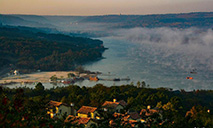Feature: Wind tunnel assists skiers in preparations for Beijing Winter Olympics
CHONGQING, Jan. 14 (Xinhua) -- A puff of freezing air bursted out from a silver-colored streamlined tunnel spanning four meters, making a whizzing sweep over bifurcated, undulating fall lines on a miniature replica of skiing slopes.
This was part of an experiment carried out using a wind tunnel in southwest China's Chongqing Municipality, as Chinese researchers attempted to figure out how turbulent airflows could affect alpine skiers during matches in the upcoming Beijing Winter Olympics.
Scientists from Chongqing University modified the device, previously often used in infrastructure wind-resistance tests. It is capable of generating a gust of 35 meters per second, tantamount to Grade 12 hurricane, to simulate the conditions encountered while skiing.
The airflow stirred a plume of smoke, emulating the whirling snowflakes set off by skiers rushing through, as repeated simulations were carried out.
When asked if this could be considered a steam engine employed to crack a nut, Li Shaopeng, a researcher with the university's wind tunnel lab, begged to differ.
The instantaneous airspeed in alpine skiing can reach 20 to 30 meters per second, which is graded ranging from gale to storm, Li said, citing the monitoring data.
"Skiers are at once affected by gravity, air resistance and lift forces, bracing power of the ground, snow friction, and skeletal muscle force," Li said.
Behind the extreme sport lies an interdisciplinary science involving sports science, kinematics, flight mechanics, aerodynamics and mathematical optimization. "Securing better sporting performance comes down to a scientific problem," said Li.
This research team has been tasked with conducting the test since Chongqing is a mountainous city and the researchers there are adept at studying mountain winds, Li added.
Yang Qingshan, the dean of the university's civil engineering school, said the wind tunnel was used for wind-resistance tests for buildings and bridges. "This is the first time they set foot in competitive sports."
Researchers started by calculating regression meteorological data from February to early March in Beijing's Yanqing competition zone where the alpine skiing match will take place.
Thereafter, they gauged the localized airspeed and wind direction based on those data, before putting a lifelike mountain mockup into the system. And finally, the data of airspeed a certain skier is going to endure was obtained.
Li Ke, associate professor of civil engineering at the university, said that these data are provided to coaches so they can optimize training and achieve better results.
Photos
Related Stories
- Winter Olympics landmark unveiled at Tiananmen Square
- Bilingual train conductor brings warmth to Winter Olympics
- UK Sport expects three to seven medals at Beijing Winter Olympics
- Lebanese experts expect China to amaze world again in Winter Olympics
- 2022 Winter Olympics: A look at venues in Yanqing and Zhangjiakou competition zones
Copyright © 2022 People's Daily Online. All Rights Reserved.










